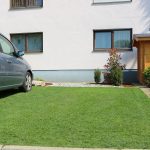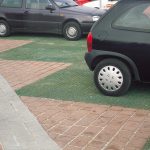Lay the lawn grid and avoid sealing the surface
Where more floors are sealed with paving stones or concrete, rainwater can no longer run off. Heavy rainfall often results in flooding. Some municipalities therefore already prescribe unsealing, others charge fees for sealed areas. If you want to fix driveways, paths or parking spaces in an ecologically compatible way, you can lay our lawn grids yourself from recycled plastic.
Stable ground and strong growth
The ground can continue to breathe by laying the lawn grids, and the green sprouting lawn also looks more attractive than grey concrete. The lawn grid ensures that the stalks grow evenly and thus cover the grid evenly just a few weeks after laying. The honeycomb material, which is available in 50 x 50 or 56 x 38 centimetre green elements, is laid over the entire area and thus offers a high static load-bearing capacity.
A benefit for ecology – and for your property
The open construction of the lawn grids makes it possible for the sown lawn to be firmly rooted in the soil. At the same time, the green area is fixed by the grille, thus providing sufficient stability. Thanks to the standard ground anchors, the lawn grids can also be used to fix embankments on one’s own property or on shore zones. Ecological aspects already play an important role during the production of the lawn grids: Our lawn grids and lawn honeycombs are manufactured in Germany under strict quality control and high production standards. It goes without saying that the components of the product are harmless to health and the environment and are 100 percent recyclable. The plastic is UV-stable, weatherproof and resistant to heat and frost – ideal conditions for a permanently paved green area. Another tip: Many local authorities even subsidise the unsealing of areas with financial subsidies. Just ask your town hall for more information.
Advantages of our lawn grids at a glance:
Our proven lawn grids combine many advantages:
- UV-stabilized material for long service life
- Available in 2 versions
- After greening, the lawn grids are fully covered.
- Temperature resistant up to + 60 degrees Celsius
- Weatherproof and frost-resistant
- Turf share from 80 to 90 percent
- Easy to lay and vibrate
- Fixed link in the area network
Another important plus point: Our lawn grids are TÜV-tested and are therefore safe and durable. Decide for a visually appealing and long-lasting surface desealing.
Lawn grids: versatile applications around the house and courtyard
Surface sealing is a thing of the past – design traffic areas & co. today in an environmentally friendly and ecological way. Literally lay a “green carpet” at the house entrance – with the practical Gutta lawn grid. The individual grids are linked by hooks and eyelets and have anchors on the underside that stabilise in the ground and prevent slipping. You can use the lawn grids in a variety of ways, for example for
- Driveways
- Parking spaces and carports
- garden paths
- pavement fixings
- Banquet attachments
- Protection of embankments
Ensure a stable substructure for your lawn grids
The construction of the substructure is important for permanent greening, where at least 8 cm of soil must be taken into account for rooting from the upper edge of the lawn grid. For a car parking area we recommend an excavation of at least 30 cm. This layer is filled with pit gravel or recycled filling material and evenly compacted (shaken off). A gradient of approx. 2% must be provided. A further layer of crushed sand / soil mixture improves the drainage effect and at the same time contains important root-forming properties. A layer (approx. 4 cm) of garden or lawn soil directly below the lawn grid considerably improves root formation and influences the durability of the lawn. Once the lawn grid has been laid, the soil is filled in and a suitable lawn is sown. It takes about 6 weeks until you can use the finished lawn.













